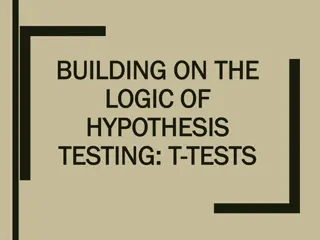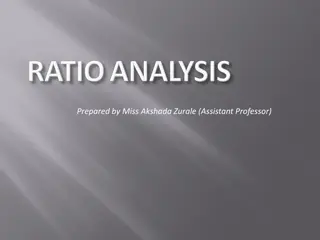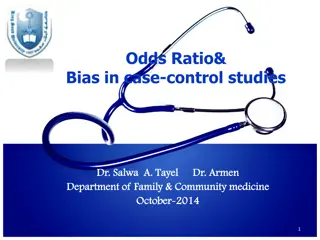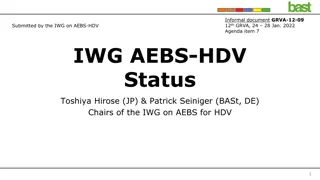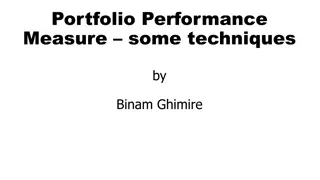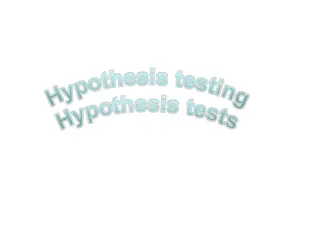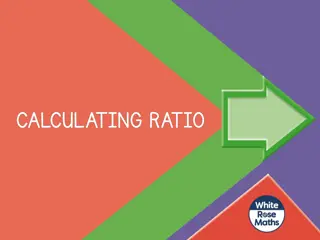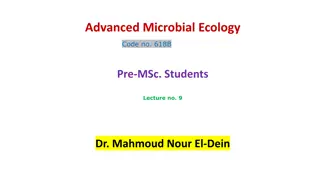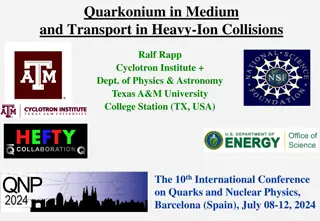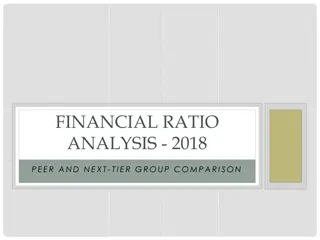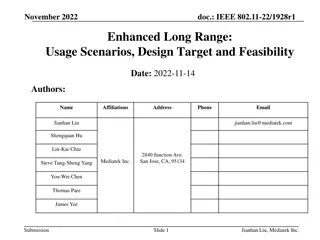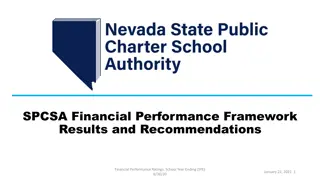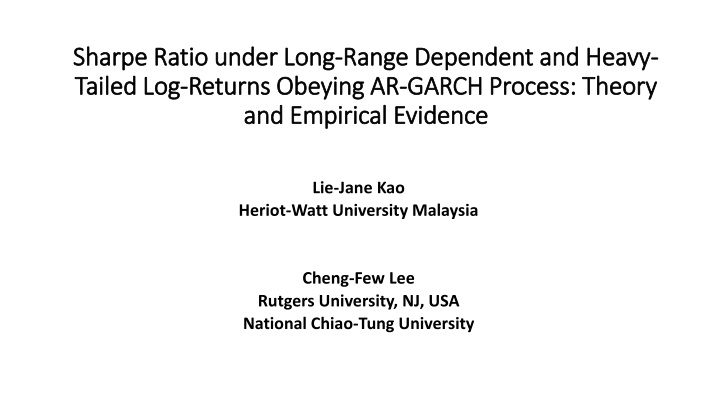
Limiting Distribution of Estimated Sharpe Ratio in Finance Studies
Explore the theoretical and empirical aspects of the Sharpe Ratio under various scenarios of log returns in finance, considering distribution properties and statistical implications. Learn about the non-central t-distribution, limiting distributions, and implications for performance measurement in investment analysis.
Download Presentation

Please find below an Image/Link to download the presentation.
The content on the website is provided AS IS for your information and personal use only. It may not be sold, licensed, or shared on other websites without obtaining consent from the author. If you encounter any issues during the download, it is possible that the publisher has removed the file from their server.
You are allowed to download the files provided on this website for personal or commercial use, subject to the condition that they are used lawfully. All files are the property of their respective owners.
The content on the website is provided AS IS for your information and personal use only. It may not be sold, licensed, or shared on other websites without obtaining consent from the author.
E N D
Presentation Transcript
Sharpe Ratio under Long Sharpe Ratio under Long- -Range Dependent and Heavy Range Dependent and Heavy- - Tailed Log Tailed Log- -Returns Obeying AR Returns Obeying AR- -GARCH Process: Theory and Empirical Evidence and Empirical Evidence GARCH Process: Theory Lie-Jane Kao Heriot-Watt University Malaysia Cheng-Few Lee Rutgers University, NJ, USA National Chiao-Tung University
Part I. Limiting Distribution of Estimated Sharpe Ratio when Log-returns are i.i.d. or Strictly-Stationary with Finite 4thMoment
(1). As the excess returns R1, , Rnare i.i.d. and normally distributed, the exact sample distribution of the estimated Sharpe ratio ? ?? is Non-central t-distributed with (n-1) d.f. with the non-central parameter ???, SR is the ex-ante Sharpe ratio. Lee, C.F., and Chen, S.N. (1979). Sampling properties of composite performance measures and their implications, Faculty Working Papers 541, The University of Illinois at Urbana-Champaign. Chen, S.N., and Lee, C.F. (1981). The sampling relationship between Sharpe s performance measure and its risk proxy: sample size, investment horizon, and market condition, Management Science, 27, 6, 607-618.
(2). As the excess returns R1, , Rnare i.i.d. and non-normally distributed, the limiting distribution ? ? ?? ?? ?(0,1 + ??2/2) Jobson, J.D. and Korkie, B.M. (1981) Performance hypothesis testing with Sharpe and Treynor measures, The Journal of Finance, 36, 4, 889-908. Lo, A. W. (2002) The statistics of Sharpe ratios, Financial Analysts Journal, 36-47.
(3). As the excess returns R1, , Rnare i.i.d. and non-normally distributed, the limiting distribution ? ? ?? ?? ?(0,VMerten) where ( ) + 2 1 1 / 4 - SR SR VMerten= 3 4 3and 4 are the skewness and kurtosis of the excess return Rt, 1 t n, Merten, E. (2002). Comments on the correct variance of estimated Sharpe Ratios in Lo (2002, FAJ) when returns are iid. Research Note (www.elmarmertens.org).
(4). As the excess returns R1, , Rnare strictly stationary and ergodic, the limiting distribution ? ? ?? ?? ?(0,VLo) where VLo is derived using the GMM technique. Lo, A. W. (2002) The statistics of Sharpe ratios, Financial Analysts Journal, 36-47.
(5). As the excess returns R1, , Rnare strictly stationary and ergodic, the limiting distribution ? ? ?? ?? ?(0,VChristie) where ( ) + 2 1 1 / 4 - SR SR VChristie= 3 4 3and 4 are the skewness and kurtosis of the excess return Rt, 1 t n, Christie, S. (2005). Is the Sharpe ratio useful in asset allocation? MAFC Research Paper No. 31, Applied Finance Center, Macquarie University. Opdyke, J.D. (2007). Comparing Sharpe ratio: So where are the p-values? Journal of Asset Management 8, 5, 208-336.
Part II. Limiting Distribution of Estimated Sharpe Ratio when Log-returns follow AR(1)-GARCH (1,1) Model
AR(1)-GARCH (1,1) Model Let Rtbe the log-return, 1 t n, and rt=Rt- be the centered log-return, rt= rt-1+Xt (1) the innovation term (2) th Xt= t the conditional variance ht= 0+ht-1At where (3) + 2 2 - t At= 1 1
Lemma 1. For the AR(1)-GARCH (1,1) model (1)-(3), if Assumptions 1-3 are satisfied and the tail index 0< <1, the limiting distribution of the scaled estimated Sharpe ratio ?? ?=1 ?? ? ? ?? ? 2 ?=1 c is a positive constant depending on the local dependency of log- returns {rt, t 1}. Note. As 0< <1, the distribution of the log-return has heavy tails that for ? 1, ? ?? ??=
Lemma 2. Under the conditions of Lemma 1, if the tail index satisfies 1< <2, the limiting distribution of the scaled estimated Sharpe ratio ? ? 1 ? ?? ?2 ? 2 ?=1 where 1. =1/ -1/2, 2. ?2 ?=1 3. c2is a positive constant depending on the local dependency of the log-returns{rt, t 1}. Note. As 1< <2, the distribution of the log-return has heavy tails that for ? 2, 2is a -stable random variable, ? ? ?? ??=
Lemma 3. Under the conditions of Lemma 1, if the tail index satisfies 2< <4, then the limiting distribution of the scaled estimated Sharpe ratio ? 2??3? /( 2) ? ?? ?? ?? where =1-2/ , ??2=Var(rt), and X is a /2-stable random variable. Note. As 2< <4, the distribution of the log-return has normal tails that for ? = 4, ? ?? ??=
Lemma 4. Under the conditions of Lemma 1, if the tail index >4, then the limiting distribution of the scaled estimated Sharpe ratio ? ? ?? ?? 2) ?(0,??? 2= 4?? 6, and ?? 4+ ?2/4?? 2=??2=Var(rt). where ??? Note. As >4, the distribution of the log-return has normal tails that for ? 4, ? ?? ??<
Limiting Distribution of Lemmas 1-4 Lemma 2. the tail index 1< <2, convergent rate ?1/ 0.5 Lemma 1. the tail index 0< <1, convergent rate ? Lemma 3. the tail index 2< <4, convergent rate ?1 2/ Lemma 4. the tail index 2< <4, convergent rate ?
Empirical Study Momentum portfolio from K.R. French s database, constructed from six value-weight portfolios formed using independent sorts on size and prior return of NYSE, AMEX, and NASDAQ stocks. Daily returns from Jan 03, 2000 to March 29, 2019 for a time horizon T= 4840 the tail index =1.257
Empirical Study Short-Reversal portfolio from K.R. French s database, constructed from six value-weight portfolios formed using independent sorts on size and prior return of NYSE, AMEX, and NASDAQ stocks. Daily returns from Jan 03, 2000 to March 29, 2019 for a time horizon T= 4840 the tail index =1.807

